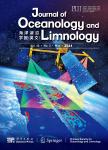Morphological and molecular diagnoses of Polydora brevipalpa Zachs,1933(Annelida: Spionidae) from the shellfish along the coast of China
Morphological and molecular diagnoses of Polydora brevipalpa Zachs,1933(Annelida: Spionidae) from the shellfish along the coast of China作者机构:Key Laboratory of Aquatic Product Processing Key Laboratory of South China Sea Fishery Resources Exploitation & Utilization Ministry of Agriculture South China Sea Fisheries Research Institute Chinese Academy of Fishery Sciences Guangzhou 510300 China Shanghai Ocean University Shanghai 201306 China
出 版 物:《Journal of Oceanology and Limnology》 (海洋湖沼学报(英文))
年 卷 期:2019年第37卷第2期
页 面:713-723页
核心收录:
学科分类:07[理学]
基 金:Supported by the National Natural Science Foundation of China(No.31301863) the Pearl River S&T Nova Program of Guangzhou(No.201710010166) the Natural Science Foundation of Guangdong Province(No.2018A030313349) the Special Scientific Research Funds for Central Non-profit Institutes,South China Sea Fisheries Research Institute,Chinese Academy of Fishery Sciences(No.2017YB08) the earmarked fund for Modern Agro-industry Technology Research System(No.CARS-49)
主 题:Polydora brevipalpa mitochondrial CO1 18S rDNA DNA barcode egg capsules
摘 要:Shell-boring species Polydora brevipalpa Zachs, 1933 is redescribed based on morphological observations and molecular approach for future unambiguous identification. Genetic distance analyses showed that the interspecific polydorid variation (16.7%–25.6%) was at least 15 times higher than the intraspecific one (0.2%–0.9%) based on the cytochrome c oxidase subunit I (CO1) gene sequences of polydorids. However, 18S rDNA variation pattern demonstrated a rather narrow barcoding gap, with the interspecific polydorid variation (0.5%–5.6%) being very close to the intraspecific one (0.0%–0.4%). As such, the CO1 gene exhibited better DNA barcode for identification of polydorids than the 18S rDNA gene because of the sufficiently large barcoding gaps. Analysis of molecular variance results based on CO1 gene sequences showed that most variations in sequences (97.79%) lay within groups of adult worms and egg capsules rather than between them. This indicated that egg capsules from Crassostrea gigas (Thunberg, 1793) in Ningbo and Nantong were related to the adult worms from Patinopecten yessoensis (Jay, 1857) in Dalian, and both of them belonged to P . brevipalpa . This result was further supported by parsimony network analysis, which showed that egg capsules collected from diff erent localities and adult worms shared a single haplotype. This study was the first to report both P . brevipalpa infestation on C . gigas and to utilise the known CO1 sequences of the adult polydorids to validate morphologically unidentified egg capsules or early larvae. P . brevipalpa was most possibly brought to Chinese waters through transportation of Pa . yessoensis brood stock from Japan.



